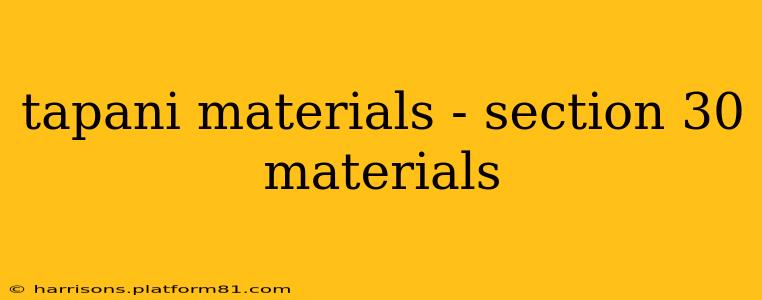Tapani Materials, a leading supplier of construction materials, offers a wide range of products. This article focuses specifically on their Section 30 materials, providing a comprehensive overview of what they are, their applications, and why they're important in construction projects. We'll delve into the specifics to answer common questions surrounding these essential materials.
What are Section 30 Materials?
Section 30 materials, often referred to as "owner-furnished materials," are items specified by the building owner or project architect and supplied directly to the contractor for incorporation into the project. This contrasts with materials procured by the contractor themselves. The "Section 30" designation comes from the section within construction contract documents where these materials are typically listed. These materials are often specialized, high-performance products, or items requiring specific sourcing or aesthetic qualities chosen by the owner to meet their vision for the project.
Why are Section 30 Materials Used?
The use of Section 30 materials offers several key advantages:
- Quality Control: Owners often specify particular brands or types to ensure the quality and performance of critical components meet their exacting standards. This gives them greater control over the end result.
- Specific Aesthetics: Section 30 materials allow owners to select finishes, colors, and styles that perfectly match their design vision, ensuring a cohesive and aesthetically pleasing outcome. Think custom tile, unique lighting fixtures, or specific types of stone.
- Lead Time Management: Certain materials have long lead times for manufacturing or delivery. By ordering them directly, owners can proactively address potential delays and ensure timely project completion.
- Cost Control (Sometimes): While sometimes more expensive upfront, specifying materials directly can, in some cases, allow for more accurate budgeting and cost control by eliminating markups from general contractors. However, it's crucial to carefully analyze pricing to ensure this is the case.
What Types of Materials are Typically Section 30?
The types of materials classified as Section 30 are quite diverse and project-specific, but commonly include:
- Specialty Finishes: High-end flooring, custom cabinetry, unique tiling, and bespoke countertops are frequently owner-specified.
- Specific Fixtures: Lighting, plumbing fixtures, and door hardware can be dictated by the owner's preferences for style and functionality.
- Structural Components: In some cases, owners may specify specialized structural elements like steel beams or precast concrete panels.
- Exterior Cladding: Unique materials like certain types of brick, stone, or metal paneling might be included as Section 30 items.
What are the Potential Challenges of Using Section 30 Materials?
While offering benefits, Section 30 materials also present potential challenges:
- Coordination: Careful coordination is required between the owner, architect, contractor, and material supplier to ensure timely delivery and proper installation. Delays can be costly.
- Storage: Responsibility for storing Section 30 materials until they're needed often falls to the contractor, requiring adequate space and protection from damage.
- Liability: Clarifying liability for damaged or lost materials before installation is critical to avoid disputes.
How Does Tapani Materials Support Section 30 Specifications?
Tapani likely offers support for Section 30 specifications through:
- Material Sourcing: They may assist in locating and securing the specific materials specified by the owner.
- Logistics: They can manage the timely delivery of these materials to the job site.
- Technical Expertise: Tapani’s expertise can provide valuable input to ensure the specified materials are correctly used and meet project requirements.
What are the advantages of using Tapani Materials for Section 30 items? (PAA Question - Paraphrased)
The advantages of using Tapani Materials for Section 30 items would depend on their specific services and the nature of the project. However, potential advantages could include their established reputation, potential for competitive pricing, their established logistics network ensuring timely delivery, and a potentially strong network of suppliers able to source hard-to-find materials.
Are there any disadvantages to using Section 30 materials? (PAA Question - Paraphrased)
As discussed earlier, potential disadvantages include coordination challenges, potential storage complications, and the need for clear liability agreements. It is also important to note that the additional oversight and communication required can add to administrative overhead for all parties involved.
How are Section 30 materials handled in a construction contract? (PAA Question - Paraphrased)
Section 30 materials are typically detailed in a specific section of the construction contract outlining the owner's responsibility for providing these materials. This section clarifies ownership, delivery schedules, storage responsibilities, and liability in case of damage or loss. The contract should clearly define the roles and responsibilities of all parties involved.
This overview provides a comprehensive understanding of Section 30 materials, specifically concerning Tapani Materials' potential role in supplying and managing these crucial components. Always consult the specific contract and relevant parties for details relating to your project.
